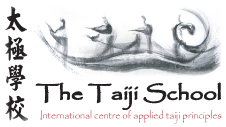Master Huang Sheng Shyan continued to refine the successful method of teaching he learnt from Cheng Man-ch’ing, developing a complete system with the underlying importance being the focus of bringing the Taiji principles into movement.
The five relaxing exercises, the 37 posture short form and the partner work are the core of the practice, with the solo exercises and form developing the internal strength and the partner work developing the sensitivity, listening and the understanding of the forces.
Attention to accuracy of physical movement, which leads to the accuracy and awareness of internal movement, is continually stressed.
The Up and Down Movement
The foundation exercise for our practice, the up and down movement (also called the “open and close”) was developed by Master Huang in the early eighties, after some twenty years after the creation of the relaxing exercises. The importance of this seemingly simple practice can not be underestimated, especially as Master Huang often mentioned that al his understanding of Taiji was in this movement.
Relaxing Exercises
The Five Relaxing Exercises were developed by Master Huang with the intent to provide the students with a systematic structure to bring the taiji principles into the body. The repetitive nature of the the movements allows the time and space for the student to constantly refine their practice.
We always learn the Relaxing Exercises first as they give us the foundation for the rest of the system. Even as a “developed” practitioner we can not afford to overlook them and must continue to work to refine them. How we move in the Relaxing Exercises will translate directly how we move in the Form and Partner Work.
Short Form
The form provides the vehicle to develop our internal strength through correcting our body alignment and structure which allows for the cultivation of deep relaxation. All of this can be achieved by integrating the taiji principles within the form.
The 37 posture Cheng Man-Ching Short Form is the foundation form in our system. The initial emphasis is to relax, loosen and open the joints. Then to foucs on developing complete accuracy within the physical postures and movement, which gradually leads to the subtle refinement of internal body movements.
List of Movements for the 37 Posture Form
Partner Work
The legendary founder explains in the last sentence of the first Taiji classic;
“The intended purpose was for the followers to attain health and longevity, not just for combat.”
This statement highlights the fact that Taiji is a martial art. A martial art with the purpose of achieving health and longevity.
The pushing hands are essential if one wants to go deeper into art of Taiji. Through the partner work the practitioners can cultivate sensitivity, listening and the understanding of the forces.
Whether practising the fixed step patterns or the free play our focus is to develop the principles of sticking, adhering, connecting and following, whilst not resisting or disconnecting.
108 Posture Sword Form
In our system we practice a 108 Posture Sword Form. This Form came from Master Huang so it is different than the form taught by Cheng man-Ching.
It is made up from six sections. The “load up and release” characteristics of the 37 Posture Short Form are also used in this form, therefore we would always recommend learning the 37 Form before attempting to learn the sword Form.
The advantage of practising the Sword Form is that it can lengthen and spread your awareness. To remain connected to the tip of the sword is a lot more difficult than remaining connected to the tip of the fingers. However the biggest hurdle most students seem to have is to just remember the movements of the form, especially as it is so long.
The Stepping Form
We developed the Stepping Form because through our experience a lot of students seemed to have problems with balance and centering when moving (stepping).
If we cannot keep our balance as soon as we start to move, then we must question, what are we actually learning? Can we only keep centered when we feel solid and stable and in a comfortable position? Life throws at us a lot of pressures and forces that we do not expect, this is when it is most necessary to remain stable, balanced and relaxed.
The stepping form is a quick, easy to learn form. Details are not focused on so we can find it more easy to keep the flow of the movement.
Conditioning
Our Conditioning exercises are developed to stimulate the body into a powerful, connected structure. We use breathing methods from White Crane and medicine ball techniques to develop this integration.
Please note, that these exercises are not “Taiji”.
While most of our work in the taichi is to let go, these exercises are designed to make you feel good through stimulation.
